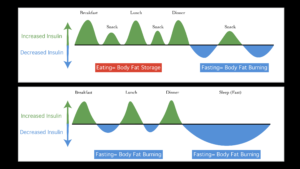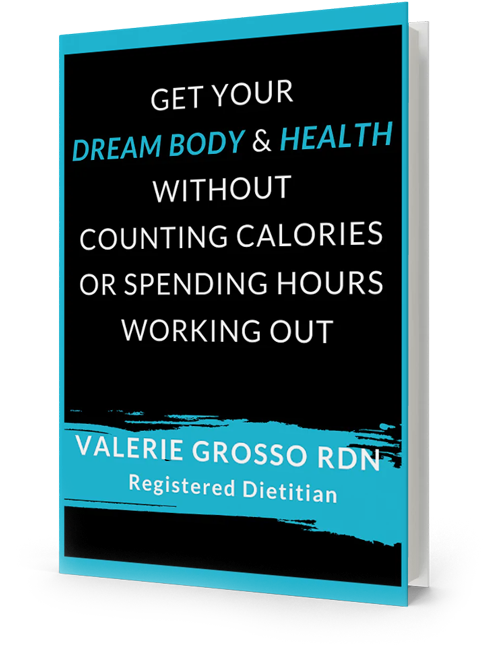What is Fasting?
This ultimate fasting guide will get you started without confusion or failure. Fasting is not starvation. It is simply alternating between periods of feeding (eating) and periods of fasting (not eating). There is really nothing new about fasting. In fact, fasting is done by all animals, cultures, religions, and people around the world since the beginning of life. It may be the most powerful dietary intervention practiced.
Fasting is a natural, healthy practice, providing many significant health benefits ranging from weight loss to reversal of disease. Fasting can last from a few hours to several days to even a week or more. Fasting has no “optimal” length but various benefits do occur at different lengths of a fast.
Fasting allows your body to use its stored energy (body fat and glycogen). Did you know that body fat is just our storage form of food energy. When we don’t eat, our body should optimally and preferentially burn body fat for fuel.
Here is what happens during FEEDING…Feeding = High Insulin + Fat Storage
When you eat, blood sugar and insulin levels rise. Some of that food energy is used by cells and tissues for energy while the remainder is stored as glycogen (limited storage space) and body fat (unlimited storage space). This stored fuel is intended to be used later, during periods of fasting. Unfortunately, our fast-paced, modern day diets and lifestyles promote body fat storage and minimize our ability to tap into our stored body fat. In fact, even a “healthy standard American diet, makes it difficult to burn body fat. Overtime, this leads to body fat accumulation, obesity, type 2 diabetes, and other chronic health problems.
Here is what happens during FASTING…Fasting = Low Insulin + Fat Burning
By naturally normalizing your hormones that control body fat storage and body fat burning, the process is essentially reversed during fasting. The key hormone, insulin, lowers during periods of fasting. As insulin levels fall (a good thing), a signal is sent to the body that food energy is not available and it is time to burn stored fuel (glycogen and body fat). The more efficient you are at using fat for fuel (metabolic efficiency), the greater percent of fat vs. glycogen (stored sugar) will be burned.
We do need to be mindful though, the body can easily access glycogen for energy. Body fat takes a bit more persuasion. Your daily nutrition will determine how quickly and efficiently you can access body fat for energy (fuel). Learn more here about nutrition to ignite body fat burning.
During extended fasting (24+ hours), the body will primarily be using all body fat for fuel.
So essentially, you have the power within you to control your body fat burning furnace.

If you take a look at the above image, you can see that if you start eating first thing in the morning, and do not stop eating until you go to bed, you will have spent most of your day in a “fed” state. Over time, you may accumulate body fat, because body fat accumulation out paced body fat burning.
So, intermittent fasting allows your body to use its stored energy…as it was designed to do. After all, why do you think we have the ability to store endless amounts of body fat? We need to use it!
Benefits of Fasting
The most commonly known benefit is weight loss, but there are many benefits. In many cultures and religions, fasting is used to cleanse, purify, and health the body. I think they are right…this fasting guide has the most commonly recognized.
Benefits may include but are not limited to…note: experiences differ individually
- Weight loss
- Body fat loss
- Increased body fat burning
- Decreased dependency on sugar (glucose) for energy
- Decreased insulin levels (insulin resistance reversal)
- Decreased inflammation
- Improved GI health
- Naturally normalizing blood sugar levels (pre-diabetes/type 2 diabetes reversal)
- Improved mental clarity and alertness
- Increased energy/decreased fatigue
- Increased growth hormone (noted on extended fasts)
- Reversal of the metabolic syndrome
- Increased autophagy (cellular replenishment and cleansing)
- Longevity benefits
- Fasting is inexpensive (it is FREE)
- Fasting requires no preparation or cooking (saves time)
Types Of Fasting
This fasting guide has commonly practiced lengths of fasts. Intermittent fasting can last from several hours (time restricted feeding) to several days or weeks. Benefits are determined by the length of your fast. Shorter fasts, like reduced eating windows can be done often, even daily. Extended, multi-day fasts should be done less frequently depending on your goals and health. Longer fasts should have medical supervision. Here you go…fasting guide types of fasts.
Shorter Fasts/Time Restricted Feeding (Less than 24 hours)
- 16 Hour Fast : 8 Hour Feed
This is often called intermittent fasting but I think it is more accurately expressed as Time Restricted Feeding (TRF). This way of fasting allows for 8 hours of eating followed by 16 hours of fasting. Typically, the 8 hours has 2-3 meals with minimal snacking. Most commonly, this is practiced daily and is fairly easy to stay consistent.
- 20 Hour Fast : 4 Hour Feed
This schedule has 4 hours of feeding followed by 20 hours of feeding. Many people on this schedule eat one meal a day (OMAD) but you are free to eat as often as desired during the 4 hours.
Longer Fasts (Greater than 24 hours)
- 24 Hour Fast
This pattern typically goes from dinner to dinner or lunch to lunch. Typically, this will be done 2-3 times per week but some people prefer to do it more often. Since you are limited to getting your nutrition in one meal, you must ensure that you are eating high nutrient dense foods and adequate protein at this meal.
- 5 Feed : 2 Fast (Weekly)
Most research has been done on this pattern. It allows for 5 days of regular eating balanced with 2 days of fasting (low caloric intake of less than 500 calories).
- Alternate Day Fasting (Every other day)
This is a cousin to the 5:2 fasting plan but you would alternate the feeding day with a fasting day.
- 36 Hour Fast
This length of fast is less commonly done. It may be more powerful for weight loss, decreasing liver fat, and insulin resistance reversal.
- Multiple Day Fast (Extended fasting)
This fasting guide is informational only…so before attempting an extended fast, consult with your healthcare provider to ensure you are not at risk for any complications. Medication reduction may be required to safely complete an extended fast. To get the benefits of an extended fast you can use a “Food Mimicking Diet”. This offers the benefits of a 5-day fast but allows for eating/drinking the foods and beverages included in the kit. I have done this several times and have had a good experience with it.
Frequently Asked Questions
Why does my blood sugar go up during a fast?
Your body has the ability to make glucose (gluconeogenesis). This occurs naturally in an effort to maintain blood sugar and provide energy to some cells/tissues. Most typically, the elevation of blood sugar occurs in the morning and then recovers to normal levels. Consult your healthcare provider if elevated blood sugars occur throughout the rest of the day.
What do I do if I get hungry during my fast?
Keep this in mind…hunger will come in like a wave. It will pass just as quickly as it rolled in. Believe it or not, hunger does not get worse in intensity. It will however show up intermittently. Embrace this moment and realize that instead of feeding the hunger, you are forcing your body to break down body fat for fuel…Awesome!
Try drinking some herbal tea, coffee, or sparkling water when this happens. Even on longer fasts, the hunger often disappears after 72 hours…amazing right?
Will I lose muscle during fasting?
During fasting, your body will breakdown glycogen (stored sugar) into glucose to use for energy and to maintain blood sugar. After glycogen stores are depleted, your body will dig into body fat stores for energy. The body does not typically rely on muscle for energy (fuel) unless it needs to.
Leaner people may be at increased risk for muscle breakdown (catabolism) but people with adequate to excessive body fat do not appear to be at risk.
Personally, I am fairly lean, practice various fasting regimes and do not feel like I am breaking down muscle for energy. Use this fasting guide to help you get started.
Fasting tips?
- Stay hydrated by drinking water. Sprinkling some salt into the water helps.
- Keep busy so you are not overly focused or preoccupied by the fast
- To combat hunger, be patient, drink coffee, tea, sparkling water.
- Following a low-carb or ketogenic diet improves fasting success
- Do not overeat or binge after a fast
Your health struggles are not your fault…..but they are your responsibility.
Valerie Grosso RDN
The Rebel Dietitian With A Mission
Want nutrition support and guidance? I can help 👇👇👇
- Download my FREE Ebook to get started: https://healthrebelblueprint.com/free
- Check out courses: https://valeriegrosso.com/courses
- Contact me for a complimentary call to discuss 1-on-1 coaching: https://valeriegrosso.com/coaching
🥳🥳Connect With Me On Social Media 🥳🥳
Facebook: https://www.facebook.com/valeriegrossord
Instagram: https://www.instagram.com/valeriegrosso
LinkedIn: www.linkedin.com/in/valeriegrosso
Twitter: @valeriegrossord
YouTube: https://www.youtube.com/channel/UCP1WB1OswXEq985r2x1G94w
UNLEASH THE POWER OF NUTRITION, IGNITE FAT BURNING, DEFY DISEASE, FEEL UNSTOPPABLE!

